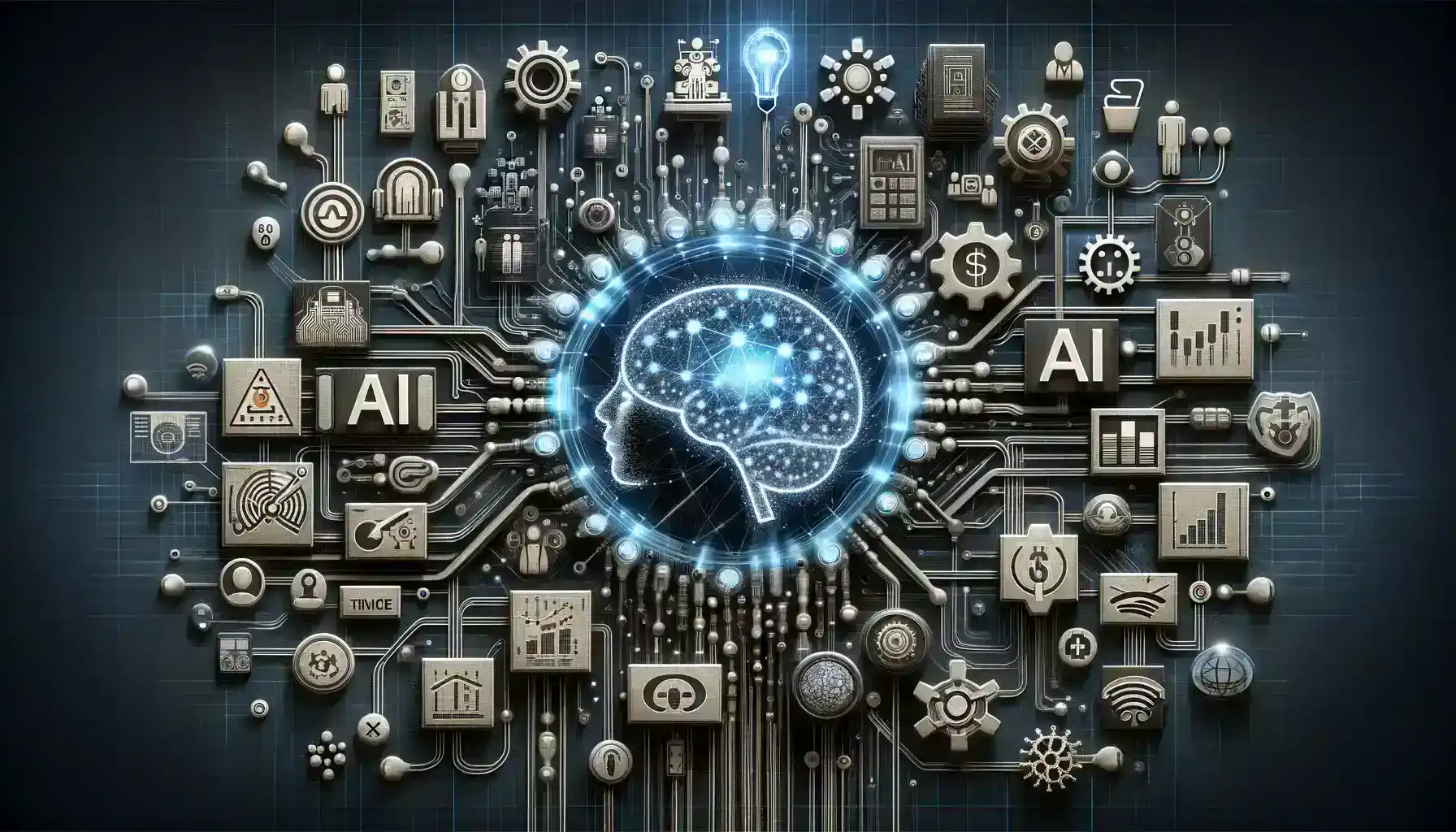Table of Contents
In the digital universe, akin to the vibrant world of Tron, Artificial Intelligence (AI) is crucial in network management, acting as the navigator in a neon-lit landscape of connections. Artificial Intelligence ensures the uninterrupted flow of data, which is vital to businesses and organizations, preventing potential disasters caused by disruptions.
With the rapid technological advancements and ubiquitous connectivity, AI’s role in orchestrating networks, and facilitating data movement like mighty rivers across the internet’s vastness, has become indispensable.

The rapid evolution of technology has brought us to the brink of a new era in network management, characterized by the integration of Artificial Intelligence (AI). As digital networks become increasingly complex and crucial for business operations, the need for more intelligent and efficient network management systems is undeniable.
This article delves into how AI is revolutionizing the field of network management, creating what we now refer to as “Smart Networks”
The Emergence of Smart Networks
Smart Networks represent a paradigm shift in how we manage digital communication systems. These networks utilize AI algorithms to analyze network traffic, predict potential issues, and automatically optimize performance. Unlike traditional network management, which relies heavily on manual monitoring and intervention, Smart Networks offer a proactive and dynamic approach.
In the Tron universe, Recognizers keep a strict watch over the digital realm. Similarly, AI in network management functions as a vigilant overseer, constantly monitoring for unusual activity, such as spikes in network traffic or unexpected user behavior shifts. This vigilant role of AI in network management has evolved through the adoption of intent-based networking (IBN).
Unlike traditional network management that relies on preset settings, IBN, empowered by AI, interprets and dynamically responds to user intentions. Artificial Intelligence’s ability to understand these intentions, predict network demands, and adjust strategies in real-time is essential for the effective functioning of IBN, making it a pivotal element in modern network management strategies.
Key Benefits of Artificial Intelligence in Network Management
In the Tron universe, the Grid significantly enhanced task execution with its rapid speeds. Similarly, AI is revolutionizing network administration and management, altering operational methodologies and maintenance. This shift brings about notable benefits in how networks function.
- Predictive Analysis: AI systems can predict network failures or congestion before they occur. By analyzing historical data and real-time inputs, these systems can identify patterns that precede common network issues, allowing for preemptive measures.
- Automated Optimization: AI enables real-time network adjustments to optimize performance. This includes dynamic routing, bandwidth allocation, and load balancing, ensuring efficient utilization of network resources.
- Enhanced Security: AI-driven networks enhance cybersecurity. Machine learning algorithms can detect and respond to security threats faster and more accurately than human operators, reducing the risk of data breaches and cyber-attacks.
- Cost Efficiency: Automating network management reduces the need for extensive human intervention, thereby cutting down operational costs. Additionally, predictive maintenance helps avoid costly downtime and repairs.
Challenges and Considerations

Integrating Artificial Intelligence (AI) into network management, while beneficial, presents several significant challenges and considerations that must be addressed. One of the primary concerns is the reliability and accuracy of AI-driven decisions. In the intricate web of network management, AI systems are often tasked with making complex decisions.
These decisions, if not precisely calibrated, can potentially lead to major disruptions, affecting not just individual operations but potentially causing widespread system malfunctions. This issue becomes more pronounced in scenarios involving large, multifaceted networks where AI must navigate through a myriad of data points and operational nuances.
Furthermore, the implementation of AI in network management demands a considerable investment in both technology and workforce training. This is not just a matter of purchasing advanced AI systems but also entails the cost of integrating these systems into existing network infrastructures. Additionally, there is a need for ongoing training and development for network professionals to effectively manage and work alongside AI tools, ensuring they can maximize the potential benefits while mitigating risks.
Another critical aspect is the concern surrounding data privacy and security. AI systems in network management operate on vast quantities of data, some of which can be sensitive or proprietary. The need to protect this data from breaches or unauthorized access is paramount. This necessitates robust security protocols and continuous vigilance to guard against potential cyber threats.
Moreover, as AI systems become more advanced, they often require access to even larger datasets, escalating the challenge of maintaining data integrity and confidentiality. Balancing the AI’s data requirements with stringent privacy and security measures is therefore a key priority in the field of AI-driven network management.
Real-World Applications
Leading companies are integrating Artificial Intelligence (AI) into network management to enhance efficiency and user experience. Cisco is at the forefront, using AI for data traffic optimization and predictive maintenance. AT&T employs AI for better managing its data networks, enhancing customer experience and operational efficiency.
IBM, a leader in AI technology, is incorporating it for anomaly detection and automated adjustments in network management. Google Cloud uses AI for real-time traffic management, ensuring high performance and seamless service. Similarly, Microsoft Azure’s network services are increasingly AI-driven, focusing on reliability and efficiency in cloud networking solutions.
- Automation and Task Orchestration: AI automates routine network tasks such as configuration, device provisioning, and updates, freeing network administrators to focus on strategic initiatives.
- Performance Optimization and Anomaly Detection: AI continuously monitors network performance, identifies anomalies, and optimizes resource allocation to maintain optimal network function and prevent congestion.
- Security Threat Detection and Mitigation: AI analyzes network traffic to detect suspicious patterns, automatically implementing measures like quarantining devices or blocking harmful traffic to mitigate security risks.
- Root Cause Analysis and Predictive Maintenance: Utilizing past and current data, AI pinpoints the causes of network disruptions and predicts future issues, enabling proactive maintenance to avoid downtime.
- Capacity Planning and Resource Management: By analyzing usage trends, AI forecasts future network demands, aiding in effective resource allocation and capacity planning.
The Future of Network Management
The future of network management is poised for a transformative shift with the increasing integration of Artificial Intelligence (AI), heralding the era of Smart Networks. This progression towards AI-centric network management is not just a trend but a fundamental change in how networks are conceived, managed, and optimized.

- Autonomous Network Operations: As Artificial Intelligence (AI) technologies advance, Smart Networks are expected to gain higher levels of autonomy. This means networks will not only self-monitor but also self-heal and self-optimize without human intervention. AI algorithms will be able to make real-time decisions to reroute traffic, balance loads, and respond to fluctuating network demands, all while maintaining optimal performance.
- Advanced Predictive Analytics: The integration of more sophisticated predictive analytics is a key component of future Smart Networks. These systems will be able to forecast network issues before they occur, predict future bandwidth requirements, and preemptively suggest infrastructure upgrades. This ability to anticipate and prepare for future scenarios will drastically reduce downtime and enhance network reliability.
- Deeper IoT Integration: The Internet of Things (IoT) is expanding rapidly, and Smart Networks will need to seamlessly integrate an ever-growing number of connected devices. AI will play a crucial role in managing these vast networks of interconnected devices, ensuring smooth communication, data flow, and security across diverse platforms and technologies.
- Enhanced Cybersecurity Measures: As networks become smarter, they also become more attractive targets for cyber threats. Future Smart Networks will employ AI to bolster their cybersecurity defenses. AI can detect and respond to security incidents more rapidly and accurately than human operators, identifying subtle patterns indicative of a cyber-attack. This proactive security approach, powered by AI, will be essential in safeguarding networks against increasingly sophisticated cyber threats.
- User-Centric Network Services: AI will enable Smart Networks to be more user-focused, providing personalized experiences based on individual user patterns and preferences. Networks will be able to dynamically adjust to provide optimal service to each user, whether it’s prioritizing bandwidth for critical applications or customizing security protocols.
- Sustainable Network Management: AI will also contribute to more sustainable network operations. By optimizing resource usage and reducing energy consumption, AI-driven networks will not only be more cost-effective but also environmentally friendly.
Conclusion
In the intersection of the visionary world of Tron and today’s AI-driven network management, a harmonious blend of fiction and reality emerges. AI’s orchestration of network data mirrors the advanced digital synchronization depicted in Tron, signaling a future where network management evolves beyond technology into a vast digital ecosystem.
AI’s pivotal role in this progression acts as a guiding light, ensuring continuous and boundless connectivity, echoing a symphony of data across the expanse of cyberspace.
AI is not just a complementary tool for network management; it’s rapidly becoming a cornerstone of how networks are managed. Smart Networks, powered by AI, are set to redefine the efficiency, reliability, and security of digital communications. As we move forward, the continuous evolution of AI will undoubtedly unlock new potentials in network management, paving the way for more innovative and resilient digital infrastructures.